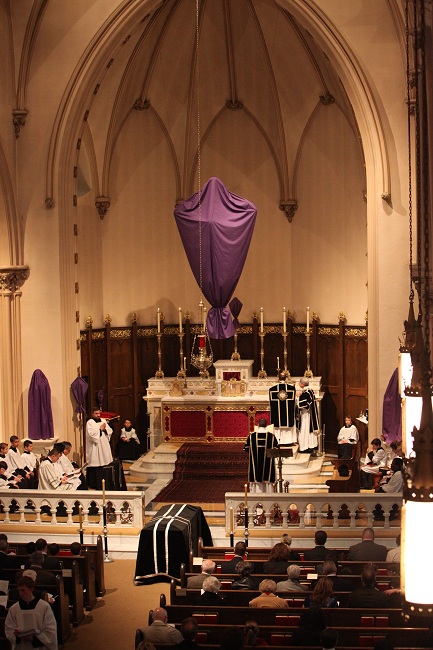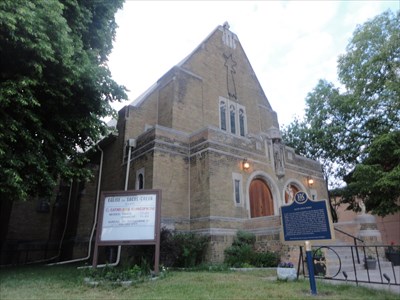In the Ordinary Form of the Roman Rite, the ars celebrandi, if not the theology, has often been described as "horizontal." By this, it is generally meant that it is more focused on community than the Divine; for example, in his great work The Spirit of the Liturgy, Pope Benedict XVI calls Mass facing the people as a "community turned inwards on itself." When one attends an Mass in the new Rite, the music is generally banal and inappropriate and while the new GIRM clearly desires all of the Mass to be sung, it is still a mish-mass of this and that. Few realise that Gregorian chant is proper to the new liturgy as well. To a large degree, this is due to the 1967 document,
Musicam Sacram, which; thankfully given
paragraph 28 of Universae Ecclesiae, does not apply to the Roman Missal 1962. Let us observe carefully this paragraph; "Furthermore, by virtue of its character of special law, within its own area, the
Motu Proprio Summorum Pontificum derogates from those provisions of law, connected with the sacred Rites, promulgated from 1962 onwards and incompatible with the rubrics of the liturgical books in effect in 1962." This is very important and in specific terms means, anything that came after which conflicts is not permitted. No Altar Girls, no communion in the hand, no communion standing (unless incapable to kneel), no Extraordinary Ministers of Holy Communion, no lay Lectors and no Sunday Anticipated Masses on Saturday evenings. It is important to note that in connection with this, the Vigil Mass of Christmas, for example, is the Mass of December 24 (in violet and therefore, an Advent liturgy) and the same would apply to the other Vigil Masses such as the Vigil Mass of Pentecost in the 1962 Missal. These are not evening Masses anticipating the next day, they are the Mass of the day prior. In the OF Missal the Vigil Masses are of a different nature and they can be celebrated after Vespers (4:00 PM) and be anticipated for the next day. In the Extraordinary Form of the Roman Rite, there are clearer definitions and certainly fewer options.

Some rubrics were modified during the legitimate liturgical movement of the first half of the 20th century. They were not so much a change in the liturgy but a change in the approach to the liturgy. For example in 1923, the first permission was given by Pope Pius XI for the "Dialogue Mass." Later, the desires of St. Pius X in
Tra le sollecitudini and Pope Pius XI with the early Dialogue permissions and again recommended by Bl. Pius X in
Mediator Dei and
De musica sacra et sacra liturgia and again by Blessed John XXIII in
Rubricarum instructum (English
here) were implemented. Truly, those that came after 1958 are less well known. There was no internet after all and parishes and people did not rush out to buy new Missals or even consider reading the version then of the GIRM.
Some questions that have been asked of us and arise are the simple terms of the Mass in the old rite and connected with these there are some important rubrics. Let us look at a simple guideline based on all of the documents above as to the names and their general rubrics relating to music and the spoken word:
Solemn Mass
 |
| A new priest's first Solemn Mass with an "Assistant Priest" present. |
Known in Latin as a Missa Solemnis, this is the norm for the Mass with priest, deacon and subdeacon. All parts, Ordinary and Proper must be sung, incense is required. Propers should be sung in Gregorian melisma but can be sung in psalm-tone or recto-tono if necessary or they can be sung in polyphonic style or a drone could be used under the chant. A Pontifical Solemn Mass is when a bishop presides and while there are additional ceremonials, the musical requirements are the same.
Semi- Solemn Mass
Unbeknownst to many, in 1963 a universal permission was granted for a Semi-Solemn Mass without a Subdeacon. The Deacon sings the Epistle and assumes many of the function of the Subdeacon except for the holding of the paten in the humeral veil. The Church was clearly interested in breaking out of the Low Mass Sunday manner of celebration so prevalent. Most parishes had at least two priests and one could have served as a Deacon for the principal Sunday celebration.
 |
| Sung Mass |
Sung Mass
The Missa Cantata is an exception. As referred to above, the Solemn Mass is the norm. The Missa Cantata was and remains a substitute as a Solemn Mass is not always possible and a Read Mass is not the ideal for the LORD's Day. The Sung Mass is without a deacon or subdeacon and the same musical rubrics apply as the Solemn Mass. Until 1962, incense was only used at a Solemn Mass but now is optional in a Sung Mass and often depends on the number of Servers. If there are sufficient, then even Torchbearers can be used during the Canon. In a Missa Cantata, all parts must be sung, Proper, Ordinary, Lesson, Epistle, Gospel and Responses.
Read Mass
 |
| Read Mass with one Server |
Often referred to by the unfortunate term "Low Mass," generally speaking, no music is permitted in a Read Mass and no incense is used except at the prescribed part of a Requiem and one Server is all that is required. As confirmed in
Universae Ecclesiae 26, the Lessons, Epistle and Gospel may be read aloud in the vernacular without first reading them in Latin, but only, in a Read Mass. In a Sung or Solemn Mass, Latin is required and they must be sung.
Read Mass with Music
In 1958, the Sacred Congregation of Rites allowed applied certain norms and discipline to the rubrics in response to varied styles of providing music from parish to parish. No Propers (Introit, Gradual, Alleluia, Tract, Sequence, Offertory or Communion) may be sung, the Gloria and Credo may not be sung. The Kyrie, Sanctus and Agnus Dei may be sung, if short. A hymn in Latin may be sung at the Entrance but must end before the Introit is recited. A motet or hymn may be sung at the Offertory and at Communion in Latin or in the vernacular, provided it has something to do with the liturgical action of each; gifts, offering and at Communion, the Eucharist or thanksgiving. A recessional hymn may be sung or the organ may be played at these parts. This is not to be confused with a Sung Mass or Missa Cantata as above and the Propers must be proclaimed audibly and must never be covered with music. The organ may be played at any parts but may not cover the said Propers.
Dialogue Mass
 |
| Solemn Requiem held during Lent |
In 1923, 1947, 1958 and reaffirmed in 1962, the Holy See encouraged the Dialogue Mass and in the latter two years, applied four levels. These range from simple responses of "et cum spiritu tuo" to the Ordinary and all the responses of the Server, specifically the Prayers at the Foot of the Altar to even, believe it or not, the reciting of the Proper Antiphons with the priest; the latter being reserved from those communities and individual capable of doing so.
Requiem Mass
No organ is to be used at any Requiem Mass except to support the singing, if absolutely necessary. No prelude, no postlude, period! A Requiem Mass' organ rules are the same as Lent and Advent, no organ solos. The Mass may be Read, Sung or Solemn in which case the norms above apply.
Rubrics are important. They keep us all on the same page and ensure that dignity and that we follow the Holy See's desires for Her liturgy. To quote from Universae Ecclesiae 24; "The liturgical books of the forma extraordinaria are to used as they are. All those who wish to celebrate according to the forma extraordinaria of the Roman Rite must know the pertinent rubrics and are obliged to follow them correctly." We must humble ourselves to the rubrics and not go our own way. Mixing the rubrics is not anticipated by the Church. Holy Mother Church gives us the guide, it is our duty to follow.
Let us all be educated in these important matters to serve loyally and faithfully. Let us not make the mistakes either out of ignorance or intent as so often found in the Ordinary Form; "I did it, my way." Let us also respect though, the established norms of existing communities of faithful and the customs to which they or their priests have maintained. The dialogue. for example, should not be forced on any individual, where it is not the custom; on the other hand, neither should anyone be chastised for engaging in it.
The Toronto Traditional Mass Society--UNA VOCE TORONTO will enthusiastically assist any priest or server or individual with gaining a greater understanding of the ars celebrandi of this venerable Rite. You may write us at unavocetoronto@rogers.com.







